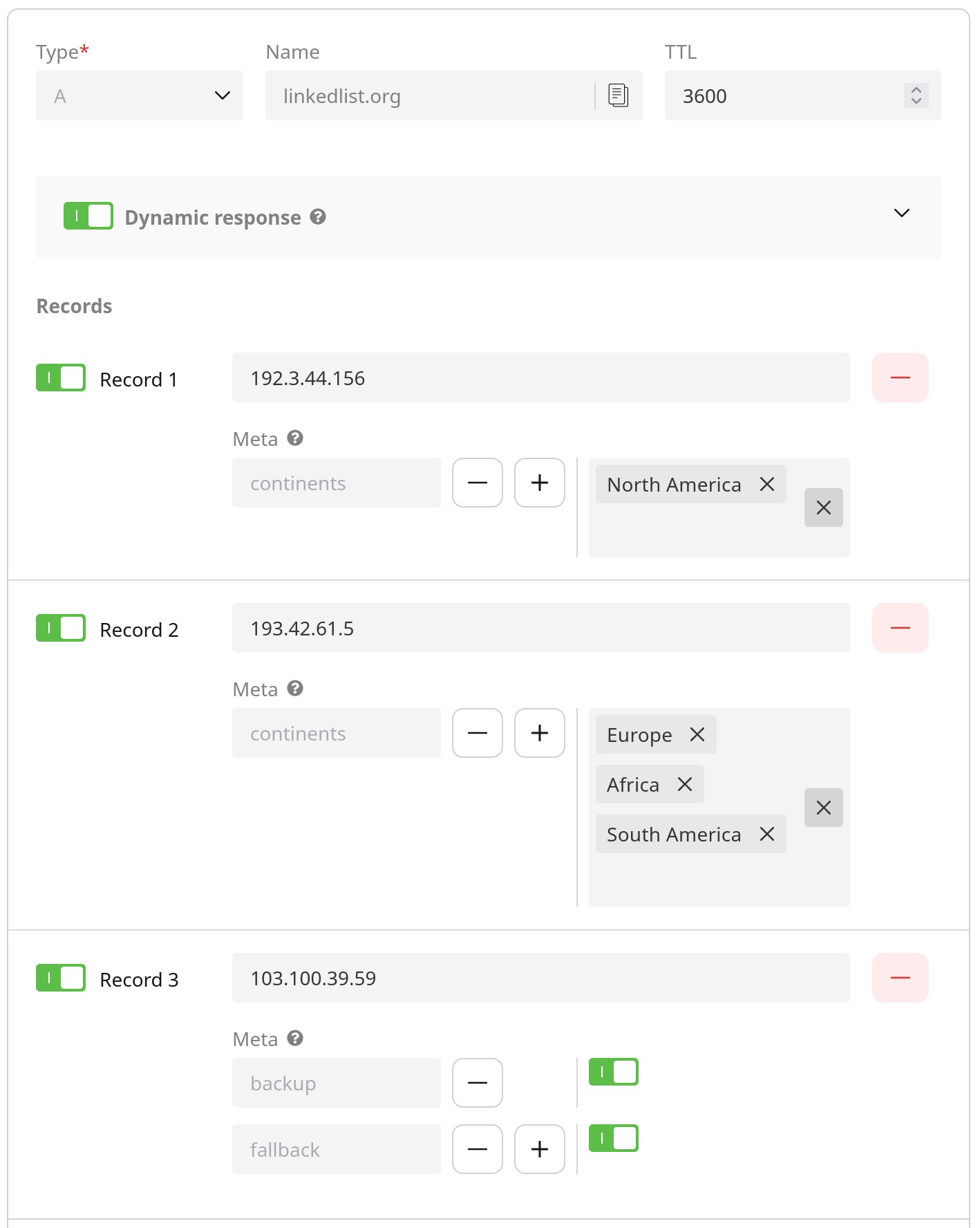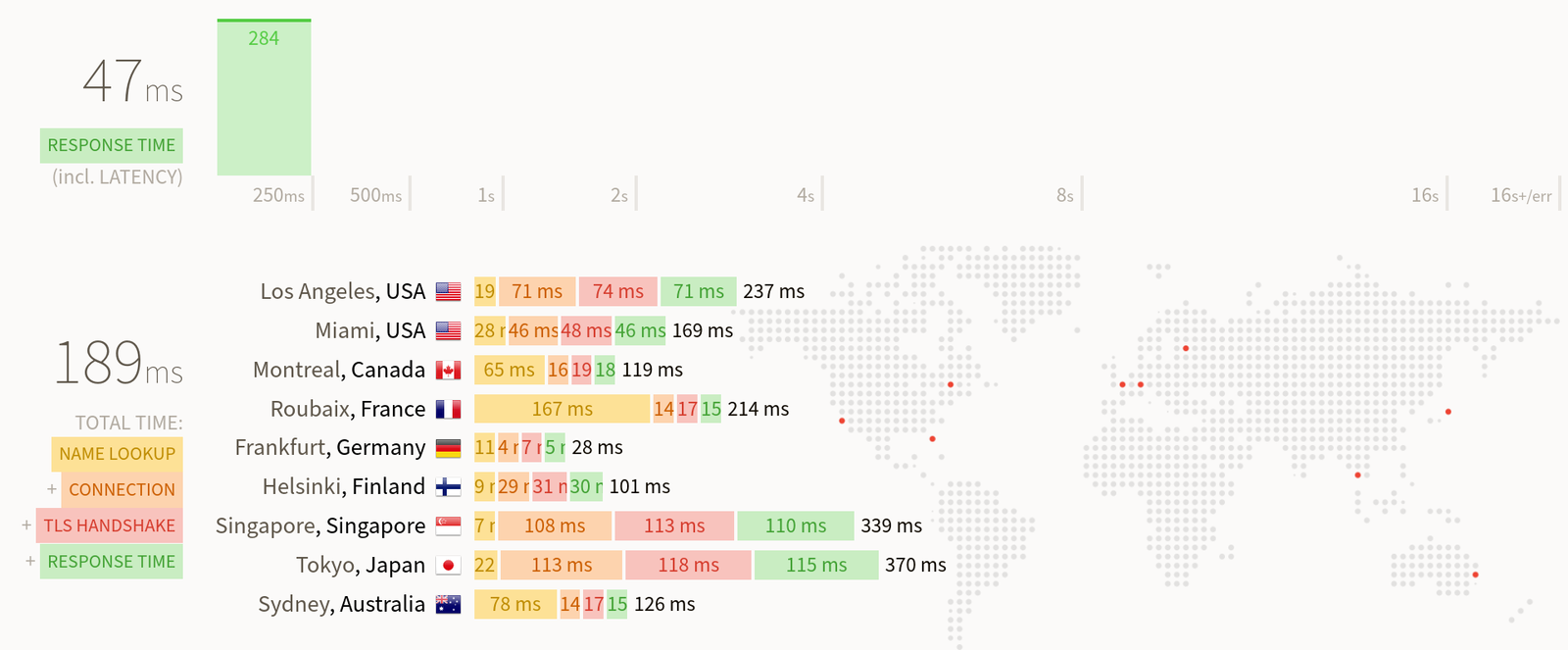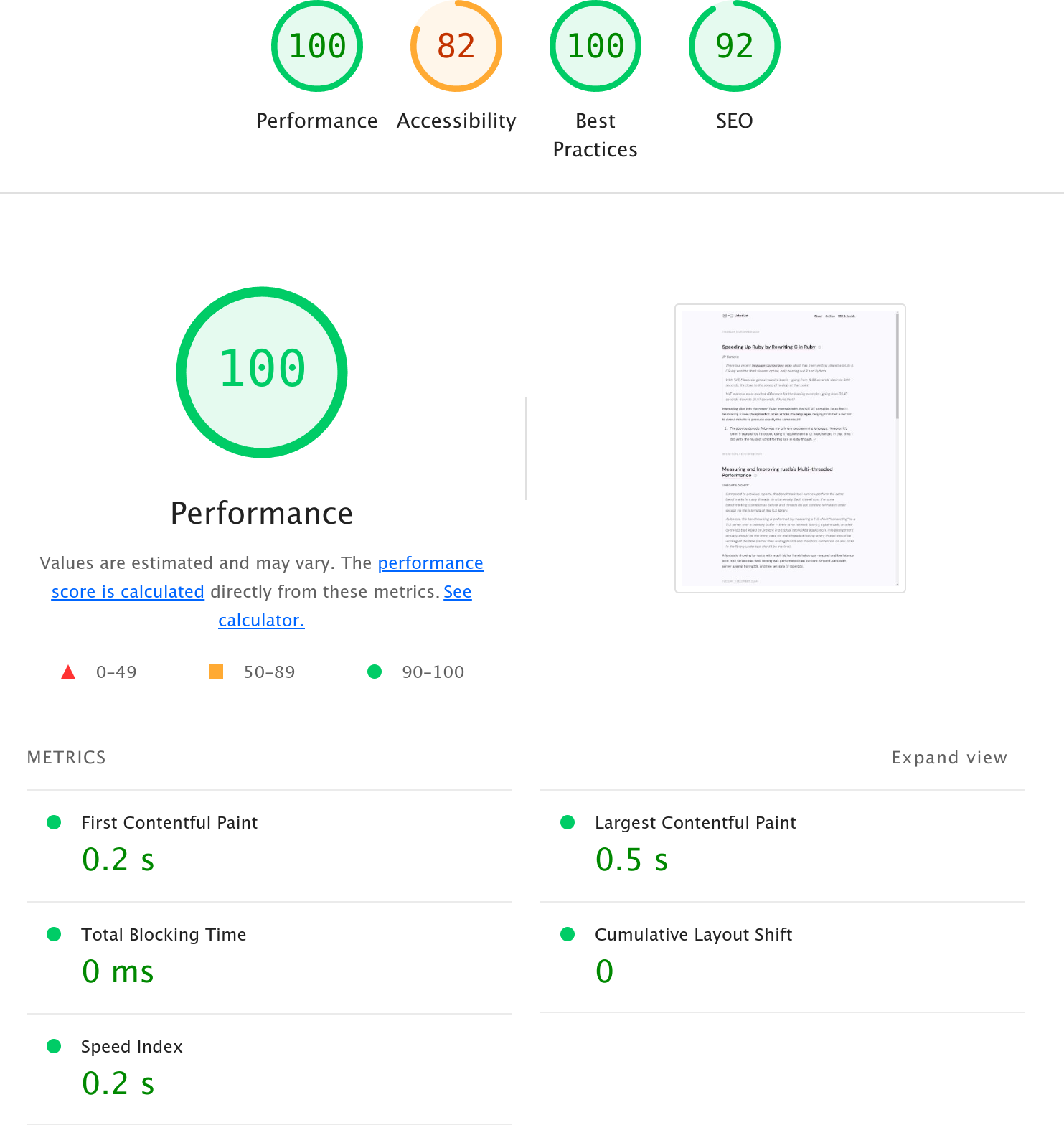In my quest to make linkedlist.org—my link blog—faster, I set up multiple deployments around the world. I used pyinfra to automate the process and Chimera Linux as the host operating system. Join me on this adventure in over-engineering to see how I dropped the average response time across nine global locations from 807ms to 189ms without spending a fortune.
A diagram of what we’re building.1
For some back story on Linked Listed see: Building and Launching My New Link Blog, linkedlist.org (Twice). While I should have been focussing on writing content for the site, I instead continued optimising what is currently a very low traffic website. Since the last post, I added caching so that the application only renders a page once. After that, the cached render result is reused for subsequent responses. These cached responses are typically generated in about a third of a millisecond (~323µs on average), which I was pretty happy with.
The problem was, for my convenience the server hosting Linked List was located in Australia, where I live. Unfortunately most other people do not live in Australia, and we’re a long way from everywhere. This meant that visitors would often encounter a lot of latency, just due to the distances covered. Is this really a problem for a lightweight website with low traffic? Not really, but it bothered me, so I set about looking into options to improve the situation.

I briefly explored options like Cloudflare and Fastly. These would have been a cheap and sensible choice, but I didn’t really feel like giving them (especially Cloudflare) even more of the Internet’s traffic, no matter how miniscule. Plus, this is a personal project I do for fun, and just sticking a hosted cache in front of it is no fun.
My stats in GoatCounter showed the top 10 visitor locations were:
- Australia
- United States
- Germany
- United Kingdom
- Netherlands
- France
- Ireland
- Japan
- Canada
- Poland
This suggested I’d get a decent improvement in latency for the most number of visitors by adding presences in Europe and the US. It’s probably worth noting at this point that due to the nature of Linked List there is no central database, so it’s a relatively simple to improve performance by deploying an instance in each location to be sped up.
Linked List is implemented in Rust and has very meagre system requirements. I did some research into bargain-basement VPS’s on LowEndBox. I found that RackNerd(affiliate link) were offering KVM based VMs with 1Gb of RAM2, custom ISO support, and US and European data centres for about US$12 per year—probably still more than Cloudflare or Fastly, but still cheap.
I created servers in the New York US datacentre, as well as France. These servers were so cheap that I wanted to make sure the network and underlying hardware was not over provisioned before committing to them. They were running on older hardware3, but after some basic testing seemed fine.
Provisioning & Configuration
To provision the servers I used some some pyinfra code I’d written previously to automate the installation of Chimera Linux in virtual machines. I picked Chimera Linux because I like it and it’s easy to do minimal installs with just the things I want. There were some other benefits described later on too.
The basic steps for provisioning were:
- Boot from the ISO and login as
root - Bootstrap ssh access to the live environment with xdotool:
xdotool windowfocus --sync $(xdotool selectwindow) type 'dinitctl start sshd && mkdir ~/.ssh && echo "ssh-rsa <key> wmoore-key" > ~/.ssh/authorized_keys && ip addr && fdisk -l'- This works with local VMs in virt-manager as well as most web-based VNC consoles provided by VPC hosts, including RackNerd.
- It uses
xdotoolto type into the selected window. The typed text enables sshd and adds my public key to the SSH authorized_keys, then prints some info about the network and disks that will be needed later.
- Run the pyinfra installation deployment against the server:
pyinfra -vvv --user root IP install-bios.py
After that, the server is rebooted and boots off its disk. I wrote subsequent pyinfra code to install and configure the server for hosting Linked List. This includes things like installing packages, creating users, nginx configuration, and ensuring services are started.
To deploy the Linked List application I defined a cports template to build Linked List as a system (apk) package:
pkgname = "linkedlist"
pkgver = "2.0.12"
pkgrel = 1
_gitrev = "5e1aed8"
_token = self.get_data("forge_token")
build_style = "cargo"
make_build_args = ["--bin", "linkedlistd"]
make_install_args = [*make_build_args]
hostmakedepends = ["cargo-auditable", "pkgconf"]
makedepends = [
"oniguruma-devel",
"rust-std",
]
pkgdesc = "Linked List web application"
maintainer = "Wesley Moore <wes@wezm.net>"
license = "custom:none"
url = "https://forge.wezm.net/wezm/linkedlist"
source = f"https://forge.wezm.net/api/v1/repos/wezm/linkedlist/archive/{_gitrev}.tar.gz?access_token={_token}>linkedlist-{pkgver}.tar.gz"
sha256 = "907978d15960b46f96fb1e5afaf3ff8dff888a00711dbe9c887e106314d85d70"
def post_install(self):
self.install_sysusers(self.files_path / "sysusers.conf")
self.install_tmpfiles(self.files_path / "tmpfiles.conf")
self.install_service(self.files_path / "linkedlist")
As shown in the post_install hook, I was also able to make use of cports
support for systemd-tmpfiles and systemd-sysusers4 to create the
linkedlist user and data directory that will hold the content of the site.
There’s also a Dinit service definition to run and manage the server:
# linkedlist service
type = process
command = /usr/bin/linkedlistd
run-as = _linkedlist
env-file = linkedlist.env
logfile = /var/log/linkedlist.log
depends-on = local.target
smooth-recovery = true
The env-file allows the configuration to be changed without needing to rebuild the package.
The servers are configured with an additional apk repository that points at
my locally built packages. A pyinfa deployment takes care of building the
packages and syncing the repo to the servers.
Using Chimera Linux and building the binary through cports has some other
neat benefits:
- The cports build tool,
cbuild, does not require a Chimera Linux host. I am able to re-build the package on my desktop that is still running Arch Linux. All that’s required is a recent version ofapk-tools, which is in the AUR. - My laptop is
aarch64 based, but the servers are not. Cross-compiling is trivial with
cbuildthough, just add-a x86_64to the./cbuild -a x86_64 pkg user/linkedlistcommand, and it doesn’t matter what host architecture I’m on. This allows me to build and deploy an updated package from the aarch64 WSL2 Chimera install on my laptop as well as my x86_64 desktop.
TLS Certificates
At this point I had the application running on the servers. Next I needed to
handle certificates for https. I usually use Lego to manage certificates
from Let’s Encrypt. This posed a challenge though, as each server needed to get
a copy of the same certificates.
I explored various options here. It’s a common problem with a bunch of hosted and self-hosted solutions. All seemed too complicated for my need of syncing two files between three servers.
One option would be to designate one of the servers the primary, and have it sync the certificates to the others. However, I wasn’t keen on one of the internet facing app servers having passwordless (key based) access to the others in order to push updated certificates to them.
In the end I revived a fanless Qotom Mini
PC I had at home. I again used my pyinfra
Chimera install scripts to set it up, followed by more pyinfra code to
configure it. This machine is responsible for managing the certificates with Lego. It
pushes out updated files when they’re renewed via a renew-hook script. The
script is managed by pyinfra and templated so that it syncs to each server in
my pyinfra inventory within the linkedlist_servers group:
#!/bin/sh -x
# push updated files to each server
# restart nginx on each server
if [ "$LEGO_CERT_DOMAIN" = "linkedlist.org" ]; then
{%- for server in linkedlist_servers %}
scp "$LEGO_CERT_PATH" "$LEGO_CERT_KEY_PATH" {{ server }}:/etc/ssl/lego/certificates/
ssh {{ server }} doas dinitctl restart nginx
{%- endfor %}
fi
The compromise here was that I had to allow the cert server ssh access to
each of the app servers, but each of the app servers has no access to the
others. I created a dedicated user for this purpose. A doas rule allows this
user to restart nginx to pick up the updated certificates:
permit nopass lego as root cmd dinitctl args restart nginx
GeoDNS
The final piece of the puzzle was how to determine which server to send a visitor to in order to minimise their latency. One option would be to use an edge compute service like Deno Deploy, and proxy the request to the desired host. However, that adds another request, with its own latency—a bit over 20ms in my testing. I wanted to avoid the extra hop, so I looked into GeoDNS. With GeoDNS the source IP of DNS requests is geo-located in order to resolve to an server IP that should minimise latency. Geo-location from IP addresses is imperfect but good enough for this project.
I settled on Gcore’s Managed DNS service as it had the necessary Geo features, a generous free tier, and a reasonable paid tier if that was ever reached. The UI is perhaps not super intuitive but I eventually got it set up as desired:

- North America is served by the US server.
- Europe, Africa, and South America are served by the French server.
- Everything else is served by the Australian server.
The default is the AU server because it’s an existing server I already had that has more RAM and CPU than the others. Some of these mappings were informed by results from PingBear (down at the time of writing). I was also able to utilise the health checking feature in Gcore to avoid resolving DNS requests to servers that are down for some reason.
Taking It Live
With the DNS sorted, I finally switched the NS records for linkedlist.org over
to Gcore and started seeing each of the servers handle traffic 🎉.
One final detail: how is new content deployed? The content is independent of
the application, which monitors the content directory for changes, reloading as
necessary. Therefore deploying new content is done with a simple rsync. All
three servers are synced in parallel, with a bit of help from xargs:
printf "au\nny\nfr\n" | xargs -P 0 -I {host} \
rsync -azhP --delete content/ {host}.linkedlist.org:/var/lib/linkedlist/content/
Deployment is actually initiated via a Makefile, so I don’t have to remember
all that: make deploy.
So how did I go, was this whole exercise in over-engineering worth it? Yep, it looks like it was. This is the end result in updown.io, which shows a decent improvement over the stats at the beginning of the post:

Most of the monitored locations are showing lower average response times. In particular, the times in Europe are much improved. It also scores 100 for performance in a Lighthouse test in Chromium:

While these results are good, I still only have a presence in three places around the world. Notably absent are servers in Asia and Africa. Should I start to see regular visitors from these or other countries the pyinfa config should make it straightforward to add servers as needed.
For now though, I need to get back to writing on Linked List. If you haven’t checked it out already please do. It’s also easy to follow via RSS, Mastodon, and Bluesky.
References
This series of three blog posts by Stefano Marinelli served as a good reference for what I was trying to achieve. Stefano uses Varnish to add a layer of caching, which I didn’t do since the application manages caching itself.
- Building a Self-Hosted CDN for BSD Cafe Media
- Make Your Own CDN With OpenBSD Base and Just 2 Packages
- Make Your Own CDN With NetBSD
-
The icons in this diagram are from the Haiku project used under the terms of their BSD license. Haiku is a really cool operating system, you should check it out. ↩
-
This gave plenty of headroom, as each server is currently only using about 240MiB of memory. ↩
-
/proc/cpuinforeports: Intel(R) Xeon(R) CPU E5-2680 v4 @ 2.40GHz ↩ -
I covered
systemd-sysusersin a previous post ↩